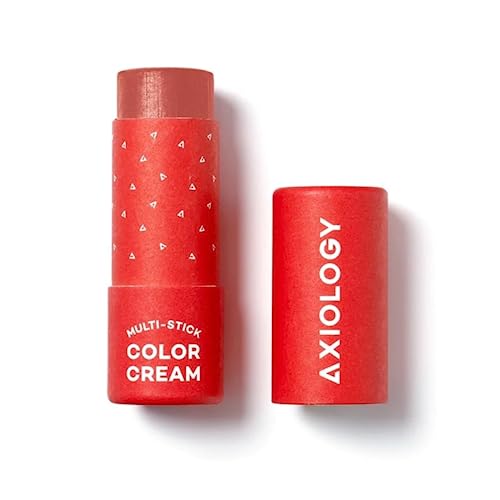

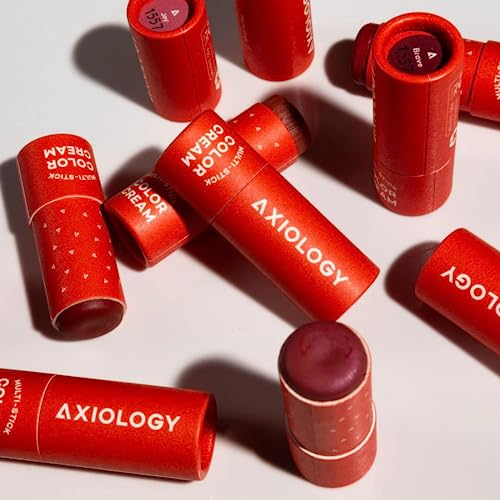
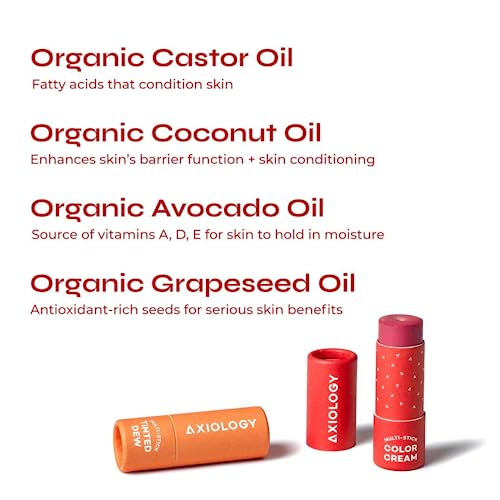
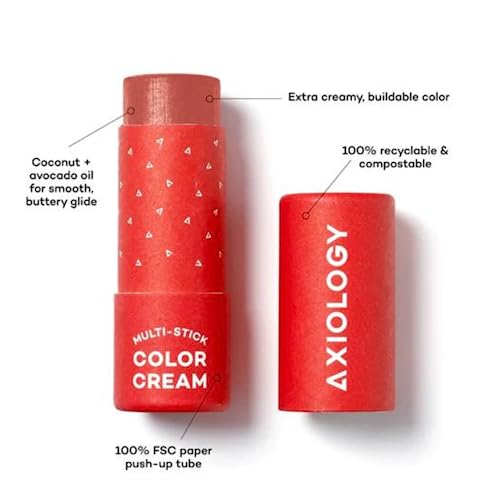



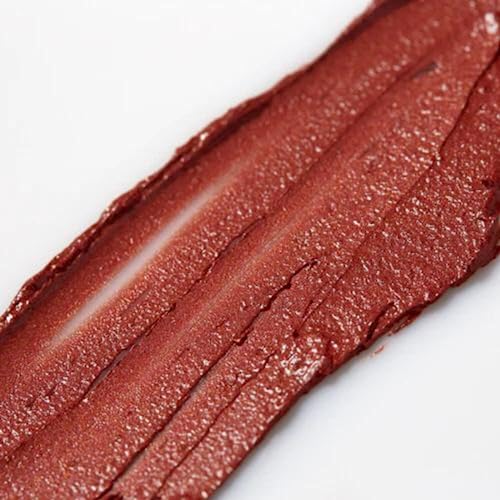
Axiology Multi-purpose Makeup Stick - Hydrating Color for Eyes, Lips, Cheeks, 0.15oz Devotion


Ricinus Communis (Castor) Seed Oil
Medium RiskCastor oil is extracted from the seeds of Ricinus communis and is commonly used in cosmetic and personal care products for its moisturizing and emollient properties. It is known for its ability to enhance skin absorption and provide a protective barrier.
Sustai Insights
Castor oil offers functional benefits as a moisturizer and emollient, enhancing skin absorption and providing a barrier against moisture loss. It is sustainably sourced and biodegradable. However, potential health risks include low levels of irritation and moderate concerns regarding developmental and reproductive toxicity. Environmental risks are low, with no significant pollutant or bioaccumulation concerns reported. Regulatory status shows no current restrictions. Overall, the risk level is assessed as medium, with recommendations for safe usage practices, and potential alternatives include other plant-based oils.
Tin Oxide
Medium RiskTin oxide is an inorganic compound often used in various products for its properties such as opacity and ability to enhance stability. It is commonly utilized in cosmetics and coatings, functioning as an opacifier and a pigment.
Sustai Insights
Tin oxide is valued for its functional benefits, including providing opacity and stability in formulations. It poses low health risks, with minimal concerns regarding carcinogenicity, allergies, or reproductive toxicity, as per regulatory evaluations. Environmentally, tin oxide is not known to contribute significantly to pollution or bioaccumulation. Regulatory bodies do not impose restrictions on its use in cosmetics. Overall, it presents a low-risk profile, making it a safe choice in product formulations.
Silica, Amorphous
Medium RiskSilica, amorphous, is a common constituent of sand and is often used in various products for its properties as an anti-caking agent, thickener, or stabilizer. It plays a crucial role in improving the texture and flow of formulations.
Sustai Insights
Amorphous silica offers functional benefits such as enhancing product texture and acting as an anti-caking agent. It poses low health risks, with minimal concerns regarding carcinogenicity, allergenic potential, and reproductive toxicity. Environmental risks are low; however, its lifecycle may involve pollution and bioaccumulation. Regulatory bodies have imposed some restrictions on its use, leading to a medium risk assessment overall. Safe usage practices should be followed, and alternatives like natural clays may provide similar benefits with reduced environmental impact.
Titanium Dioxide
Medium RiskTitanium dioxide is an inorganic compound used primarily as a pigment due to its brightness and high refractive index. It is commonly found in products such as paints, coatings, plastics, and cosmetics, providing color and opacity.
Sustai Insights
Titanium dioxide serves effectively as a UV filter and colorant, enhancing product stability and performance. However, it has been classified as a moderate concern for potential carcinogenicity and carries low risks for allergies and reproductive toxicity. Environmental risks include its pollutant potential, though it is not known to bioaccumulate. Regulatory bodies have issued specific restrictions regarding its use, leading to an overall medium risk assessment. Safe usage practices should be observed, with consideration for alternatives such as zinc oxide for a more sustainable option.
Tin Oxide
Low RiskTin oxide is an inorganic compound often used in various products for its properties such as opacity and ability to enhance stability. It is commonly utilized in cosmetics and coatings, functioning as an opacifier and a pigment.
Sustai Insights
Tin oxide is valued for its functional benefits, including providing opacity and stability in formulations. It poses low health risks, with minimal concerns regarding carcinogenicity, allergies, or reproductive toxicity, as per regulatory evaluations. Environmentally, tin oxide is not known to contribute significantly to pollution or bioaccumulation. Regulatory bodies do not impose restrictions on its use in cosmetics. Overall, it presents a low-risk profile, making it a safe choice in product formulations.
Persea Gratissima (Avocado) Oil
Low RiskPersea gratissima (avocado) oil is derived from the fruit of the avocado tree. It is commonly used in cosmetic formulations for its moisturizing properties, serving as an emollient that enhances skin hydration and improves product texture.
Sustai Insights
Avocado oil offers functional benefits as a moisturizer and emollient, known for its ability to nourish and hydrate the skin. It is sustainably sourced and biodegradable. Health risks are minimal, with low concerns regarding carcinogenicity, allergies, and reproductive toxicity. Environmental risks are also low, with no significant pollutant or bioaccumulation potential. Regulatory bodies have not issued warnings against its use. Overall, the ingredient is assessed as low risk, making it a safe choice for cosmetic applications.
Sambucus Nigra (Elder) Fruit Extract
Low RiskSambucus nigra (elder) fruit extract is derived from the berries of the elderberry plant. It is commonly used in various formulations for its antioxidant properties and potential health benefits, such as supporting immune function and providing a natural flavoring agent in products.
Sustai Insights
Sambucus nigra fruit extract offers functional benefits, particularly as an antioxidant and potential immune booster, while being sustainably sourced. Health risks are low, with minimal concerns regarding carcinogenicity, allergies, or reproductive toxicity. Environmental impacts are not significant, and it is not currently restricted by regulatory bodies. The overall risk level is low, making it a safe ingredient in formulations. Safe usage practices include using it at established concentrations, and alternatives may include other plant extracts with similar properties.
Azadirachta Indica (Neem) Seed Oil
Low RiskAzadirachta indica (neem) seed oil is derived from the seeds of the neem tree. It is commonly used in cosmetic and personal care products for its potential properties as an emollient and its traditional use in herbal medicine. Its applications include skin care, hair care, and as an insect repellent.
Sustai Insights
Neem seed oil offers functional benefits such as moisturizing and potential antimicrobial properties, making it useful in personal care formulations. It is considered sustainably sourced and biodegradable. Health risks are low, with minimal concerns regarding carcinogenicity, allergies, or reproductive toxicity. Environmental risks are also low, with no significant pollutant or bioaccumulation potential. Regulatory status shows no current restrictions. Overall, it is assessed to have a low risk, making it a favorable choice in formulations.
Synthetic Fluorphlogopite
Low RiskSynthetic fluorphlogopite is a synthetic mineral composed of fluorine, aluminum, and silicate. It is primarily used in cosmetic products for its unique shimmering properties and is valued for its ability to enhance product texture and appearance.
Sustai Insights
Synthetic fluorphlogopite offers functional benefits such as providing a soft-focus effect and shimmer in cosmetic formulations. It is considered to have low health risks, with no significant concerns regarding carcinogenicity, allergies, or reproductive toxicity. Environmentally, it poses minimal risks, being non-bioaccumulative and not contributing to pollution. Regulatory assessments indicate it is not banned or heavily restricted. Overall, the ingredient presents a low-risk profile, making it a suitable choice in cosmetic applications.
Helianthus Annus (Sunflower) Seed Wax
Low RiskHelianthus annuus (sunflower) seed wax is a naturally derived wax obtained from sunflower seeds, primarily used for its emollient properties in cosmetic formulations. It serves as a thickening agent, stabilizer, and moisture-retaining component, contributing to the texture and consistency of various products.
Sustai Insights
Sunflower seed wax offers functional benefits such as enhancing product texture and acting as a natural emulsifier. It is biodegradable and sourced sustainably, which aligns with eco-friendly practices. Health risks associated with this ingredient are low, with no significant concerns regarding carcinogenicity, allergies, or reproductive toxicity noted. Additionally, it does not pose environmental hazards, as it is not classified as a pollutant or bioaccumulative. Regulatory assessments indicate no current restrictions, resulting in an overall low risk level. Safe usage practices should be followed, and while alternatives exist, sunflower seed wax is a suitable option for many formulations.
Vitis Vinifera (Grape) Seed Oil
Low RiskVitis vinifera (grape) seed oil is derived from the seeds of grapes, primarily used in cosmetics for its emollient properties. It acts as a moisturizer and is often included in formulations for skin care products due to its fatty acid composition and antioxidant potential.
Sustai Insights
Grape seed oil provides functional benefits as an effective moisturizer and antioxidant, contributing to skin hydration and protection. It is sustainably sourced and biodegradable. Health risks are low, with minimal concerns regarding carcinogenicity, allergies, or reproductive toxicity. Environmental impact is also low, with no significant pollutant potential. Regulatory bodies do not impose restrictions on its use. Overall, the ingredient poses a low risk, making it a safe choice in cosmetic formulations.
Hydrogenated Soybean Oil
Low RiskHydrogenated soybean oil is an end product of the hydrogenation process applied to soybean oil, resulting in a semi-solid fat. It is commonly used in food products and cosmetics for its emulsifying and stabilizing properties.
Sustai Insights
Hydrogenated soybean oil provides effective emulsification and stability in products. It is generally recognized as safe, with low concerns regarding carcinogenicity, allergies, and reproductive toxicity. However, it may pose environmental risks if improperly disposed of, and there are regulatory restrictions on certain uses. Overall, the risk level is assessed as low, and safe usage practices should be followed. Alternatives may include non-hydrogenated oils that offer similar functional benefits.
Manganese Violet
Low RiskManganese violet is an inorganic salt formed from ammonium manganese phosphate, primarily used as a pigment in cosmetics and personal care products. It imparts a vivid violet color and is valued for its stability and opacity in formulations.
Sustai Insights
Manganese violet serves effectively as a colorant, contributing to aesthetic appeal in various products. It is considered to have low health risks, including negligible concerns regarding carcinogenicity, allergies, and reproductive toxicity. Environmentally, it poses low risks, being neither bioaccumulative nor a significant pollutant. Regulatory bodies, including the FDA, have imposed certain restrictions on its use but deem it generally safe when used appropriately. Overall, it presents a low risk profile, making it a suitable choice for formulation in personal care applications.
Mica
Low RiskMica is a type of highly brittle silicate mineral commonly used in cosmetics and personal care products for its reflective properties and texture. It serves primarily as a colorant and opacifying agent, enhancing the aesthetic appeal of formulations.
Sustai Insights
Mica provides functional benefits such as adding shimmer and improving the texture of cosmetics. It is generally considered low risk concerning health concerns like carcinogenicity and allergenic potential. However, there are risks associated with its persistence and potential for bioaccumulation in the environment. Regulatory bodies have noted some restrictions on mica sourcing due to ethical concerns surrounding mining practices. Overall, while mica has low health risks, its environmental impact necessitates careful sourcing and consideration of alternatives like synthetic colorants or other natural minerals.
Ci 77499
Low RiskCI 77499, also known as iron oxides, are inorganic pigments commonly used in cosmetic products for their coloring properties. They provide a range of shades and are often included for their stability and opacity, enhancing the visual appeal of formulations.
Sustai Insights
CI 77499 offers functional benefits as a stable colorant, contributing to product aesthetics without significant health risks, as concerns for carcinogenicity, allergies, and reproductive toxicity are low. However, it has high persistence and bioaccumulation potential in the environment, raising ecotoxicity concerns. Regulatory restrictions exist for certain uses. Overall, the ingredient presents a low risk profile when used according to safety guidelines, with alternatives available for those seeking greener options.
Tocopherol
Low RiskTocopherols are a class of naturally occurring compounds, primarily known for their role as antioxidants. They are commonly used in cosmetic and skincare products to help stabilize formulations and protect ingredients from oxidative damage.
Sustai Insights
Tocopherols provide functional benefits such as antioxidant protection and skin conditioning. They are generally recognized as safe, with low concerns regarding carcinogenicity, allergies, and reproductive toxicity. However, enhanced skin absorption and potential endocrine disruption are noted. Regulatory bodies have not imposed significant restrictions on tocopherols, categorizing the overall risk as low. Safe usage practices should be observed, and while alternatives exist, tocopherols remain a viable option in formulations.
Cocos Nucifera (Coconut) Oil
Low RiskCocos Nucifera (Coconut) Oil is derived from the kernels of the coconut palm. It is primarily used in cosmetic formulations for its emollient and moisturizing properties, making it suitable for skin and hair care products.
Sustai Insights
Coconut oil serves as an effective moisturizer and emollient, promoting skin hydration and softness. It is sustainably sourced and biodegradable. Health risks are minimal, with low concerns regarding carcinogenicity, allergens, and reproductive toxicity. Environmental impact is also low, as it does not contribute significantly to pollution or bioaccumulation. Regulatory bodies have not issued restrictions on its use. Overall, coconut oil presents a low risk for health and environmental concerns, making it a safe ingredient in cosmetic products.
Helianthus Annuus (Sunflower) Seed Oil
Low RiskHelianthus annuus (sunflower) seed oil is derived from the seeds of the sunflower plant. It serves primarily as an emollient and moisturizer in cosmetic formulations, helping to maintain skin hydration and improve texture.
Sustai Insights
Sunflower seed oil is effective as an emollient, providing moisture and improving skin texture while being biodegradable and sustainably sourced. It poses low health risks, including negligible concerns for carcinogenicity, allergies, or reproductive toxicity. Environmentally, it does not significantly contribute to pollution or bioaccumulation. Regulatory bodies currently do not list any advisories for this ingredient. Overall, it is assessed as low risk, with safe usage practices recommended. Alternatives include oils like jojoba or almond oil for those seeking different properties.
Ricinus Communis (Castor) Seed Oil
Medium RiskCastor oil is extracted from the seeds of Ricinus communis and is commonly used in cosmetic and personal care products for its moisturizing and emollient properties. It is known for its ability to enhance skin absorption and provide a protective barrier.
Sustai Insights
Castor oil offers functional benefits as a moisturizer and emollient, enhancing skin absorption and providing a barrier against moisture loss. It is sustainably sourced and biodegradable. However, potential health risks include low levels of irritation and moderate concerns regarding developmental and reproductive toxicity. Environmental risks are low, with no significant pollutant or bioaccumulation concerns reported. Regulatory status shows no current restrictions. Overall, the risk level is assessed as medium, with recommendations for safe usage practices, and potential alternatives include other plant-based oils.
Tin Oxide
Low RiskTin oxide is an inorganic compound often used in various products for its properties such as opacity and ability to enhance stability. It is commonly utilized in cosmetics and coatings, functioning as an opacifier and a pigment.
Sustai Insights
Tin oxide is valued for its functional benefits, including providing opacity and stability in formulations. It poses low health risks, with minimal concerns regarding carcinogenicity, allergies, or reproductive toxicity, as per regulatory evaluations. Environmentally, tin oxide is not known to contribute significantly to pollution or bioaccumulation. Regulatory bodies do not impose restrictions on its use in cosmetics. Overall, it presents a low-risk profile, making it a safe choice in product formulations.
Tin Oxide
Medium RiskTin oxide is an inorganic compound often used in various products for its properties such as opacity and ability to enhance stability. It is commonly utilized in cosmetics and coatings, functioning as an opacifier and a pigment.
Sustai Insights
Tin oxide is valued for its functional benefits, including providing opacity and stability in formulations. It poses low health risks, with minimal concerns regarding carcinogenicity, allergies, or reproductive toxicity, as per regulatory evaluations. Environmentally, tin oxide is not known to contribute significantly to pollution or bioaccumulation. Regulatory bodies do not impose restrictions on its use in cosmetics. Overall, it presents a low-risk profile, making it a safe choice in product formulations.
Persea Gratissima (Avocado) Oil
Low RiskPersea gratissima (avocado) oil is derived from the fruit of the avocado tree. It is commonly used in cosmetic formulations for its moisturizing properties, serving as an emollient that enhances skin hydration and improves product texture.
Sustai Insights
Avocado oil offers functional benefits as a moisturizer and emollient, known for its ability to nourish and hydrate the skin. It is sustainably sourced and biodegradable. Health risks are minimal, with low concerns regarding carcinogenicity, allergies, and reproductive toxicity. Environmental risks are also low, with no significant pollutant or bioaccumulation potential. Regulatory bodies have not issued warnings against its use. Overall, the ingredient is assessed as low risk, making it a safe choice for cosmetic applications.
Sambucus Nigra (Elder) Fruit Extract
Low RiskSambucus nigra (elder) fruit extract is derived from the berries of the elderberry plant. It is commonly used in various formulations for its antioxidant properties and potential health benefits, such as supporting immune function and providing a natural flavoring agent in products.
Sustai Insights
Sambucus nigra fruit extract offers functional benefits, particularly as an antioxidant and potential immune booster, while being sustainably sourced. Health risks are low, with minimal concerns regarding carcinogenicity, allergies, or reproductive toxicity. Environmental impacts are not significant, and it is not currently restricted by regulatory bodies. The overall risk level is low, making it a safe ingredient in formulations. Safe usage practices include using it at established concentrations, and alternatives may include other plant extracts with similar properties.
Azadirachta Indica (Neem) Seed Oil
Low RiskAzadirachta indica (neem) seed oil is derived from the seeds of the neem tree. It is commonly used in cosmetic and personal care products for its potential properties as an emollient and its traditional use in herbal medicine. Its applications include skin care, hair care, and as an insect repellent.
Sustai Insights
Neem seed oil offers functional benefits such as moisturizing and potential antimicrobial properties, making it useful in personal care formulations. It is considered sustainably sourced and biodegradable. Health risks are low, with minimal concerns regarding carcinogenicity, allergies, or reproductive toxicity. Environmental risks are also low, with no significant pollutant or bioaccumulation potential. Regulatory status shows no current restrictions. Overall, it is assessed to have a low risk, making it a favorable choice in formulations.
Synthetic Fluorphlogopite
Low RiskSynthetic fluorphlogopite is a synthetic mineral composed of fluorine, aluminum, and silicate. It is primarily used in cosmetic products for its unique shimmering properties and is valued for its ability to enhance product texture and appearance.
Sustai Insights
Synthetic fluorphlogopite offers functional benefits such as providing a soft-focus effect and shimmer in cosmetic formulations. It is considered to have low health risks, with no significant concerns regarding carcinogenicity, allergies, or reproductive toxicity. Environmentally, it poses minimal risks, being non-bioaccumulative and not contributing to pollution. Regulatory assessments indicate it is not banned or heavily restricted. Overall, the ingredient presents a low-risk profile, making it a suitable choice in cosmetic applications.
Helianthus Annus (Sunflower) Seed Wax
Low RiskHelianthus annuus (sunflower) seed wax is a naturally derived wax obtained from sunflower seeds, primarily used for its emollient properties in cosmetic formulations. It serves as a thickening agent, stabilizer, and moisture-retaining component, contributing to the texture and consistency of various products.
Sustai Insights
Sunflower seed wax offers functional benefits such as enhancing product texture and acting as a natural emulsifier. It is biodegradable and sourced sustainably, which aligns with eco-friendly practices. Health risks associated with this ingredient are low, with no significant concerns regarding carcinogenicity, allergies, or reproductive toxicity noted. Additionally, it does not pose environmental hazards, as it is not classified as a pollutant or bioaccumulative. Regulatory assessments indicate no current restrictions, resulting in an overall low risk level. Safe usage practices should be followed, and while alternatives exist, sunflower seed wax is a suitable option for many formulations.
Vitis Vinifera (Grape) Seed Oil
Low RiskVitis vinifera (grape) seed oil is derived from the seeds of grapes, primarily used in cosmetics for its emollient properties. It acts as a moisturizer and is often included in formulations for skin care products due to its fatty acid composition and antioxidant potential.
Sustai Insights
Grape seed oil provides functional benefits as an effective moisturizer and antioxidant, contributing to skin hydration and protection. It is sustainably sourced and biodegradable. Health risks are low, with minimal concerns regarding carcinogenicity, allergies, or reproductive toxicity. Environmental impact is also low, with no significant pollutant potential. Regulatory bodies do not impose restrictions on its use. Overall, the ingredient poses a low risk, making it a safe choice in cosmetic formulations.
Hydrogenated Soybean Oil
Low RiskHydrogenated soybean oil is an end product of the hydrogenation process applied to soybean oil, resulting in a semi-solid fat. It is commonly used in food products and cosmetics for its emulsifying and stabilizing properties.
Sustai Insights
Hydrogenated soybean oil provides effective emulsification and stability in products. It is generally recognized as safe, with low concerns regarding carcinogenicity, allergies, and reproductive toxicity. However, it may pose environmental risks if improperly disposed of, and there are regulatory restrictions on certain uses. Overall, the risk level is assessed as low, and safe usage practices should be followed. Alternatives may include non-hydrogenated oils that offer similar functional benefits.
Manganese Violet
Low RiskManganese violet is an inorganic salt formed from ammonium manganese phosphate, primarily used as a pigment in cosmetics and personal care products. It imparts a vivid violet color and is valued for its stability and opacity in formulations.
Sustai Insights
Manganese violet serves effectively as a colorant, contributing to aesthetic appeal in various products. It is considered to have low health risks, including negligible concerns regarding carcinogenicity, allergies, and reproductive toxicity. Environmentally, it poses low risks, being neither bioaccumulative nor a significant pollutant. Regulatory bodies, including the FDA, have imposed certain restrictions on its use but deem it generally safe when used appropriately. Overall, it presents a low risk profile, making it a suitable choice for formulation in personal care applications.
Silica, Amorphous
Medium RiskSilica, amorphous, is a common constituent of sand and is often used in various products for its properties as an anti-caking agent, thickener, or stabilizer. It plays a crucial role in improving the texture and flow of formulations.
Sustai Insights
Amorphous silica offers functional benefits such as enhancing product texture and acting as an anti-caking agent. It poses low health risks, with minimal concerns regarding carcinogenicity, allergenic potential, and reproductive toxicity. Environmental risks are low; however, its lifecycle may involve pollution and bioaccumulation. Regulatory bodies have imposed some restrictions on its use, leading to a medium risk assessment overall. Safe usage practices should be followed, and alternatives like natural clays may provide similar benefits with reduced environmental impact.
Mica
Low RiskMica is a type of highly brittle silicate mineral commonly used in cosmetics and personal care products for its reflective properties and texture. It serves primarily as a colorant and opacifying agent, enhancing the aesthetic appeal of formulations.
Sustai Insights
Mica provides functional benefits such as adding shimmer and improving the texture of cosmetics. It is generally considered low risk concerning health concerns like carcinogenicity and allergenic potential. However, there are risks associated with its persistence and potential for bioaccumulation in the environment. Regulatory bodies have noted some restrictions on mica sourcing due to ethical concerns surrounding mining practices. Overall, while mica has low health risks, its environmental impact necessitates careful sourcing and consideration of alternatives like synthetic colorants or other natural minerals.
Ci 77499
Low RiskCI 77499, also known as iron oxides, are inorganic pigments commonly used in cosmetic products for their coloring properties. They provide a range of shades and are often included for their stability and opacity, enhancing the visual appeal of formulations.
Sustai Insights
CI 77499 offers functional benefits as a stable colorant, contributing to product aesthetics without significant health risks, as concerns for carcinogenicity, allergies, and reproductive toxicity are low. However, it has high persistence and bioaccumulation potential in the environment, raising ecotoxicity concerns. Regulatory restrictions exist for certain uses. Overall, the ingredient presents a low risk profile when used according to safety guidelines, with alternatives available for those seeking greener options.
Tocopherol
Low RiskTocopherols are a class of naturally occurring compounds, primarily known for their role as antioxidants. They are commonly used in cosmetic and skincare products to help stabilize formulations and protect ingredients from oxidative damage.
Sustai Insights
Tocopherols provide functional benefits such as antioxidant protection and skin conditioning. They are generally recognized as safe, with low concerns regarding carcinogenicity, allergies, and reproductive toxicity. However, enhanced skin absorption and potential endocrine disruption are noted. Regulatory bodies have not imposed significant restrictions on tocopherols, categorizing the overall risk as low. Safe usage practices should be observed, and while alternatives exist, tocopherols remain a viable option in formulations.
Titanium Dioxide
Medium RiskTitanium dioxide is an inorganic compound used primarily as a pigment due to its brightness and high refractive index. It is commonly found in products such as paints, coatings, plastics, and cosmetics, providing color and opacity.
Sustai Insights
Titanium dioxide serves effectively as a UV filter and colorant, enhancing product stability and performance. However, it has been classified as a moderate concern for potential carcinogenicity and carries low risks for allergies and reproductive toxicity. Environmental risks include its pollutant potential, though it is not known to bioaccumulate. Regulatory bodies have issued specific restrictions regarding its use, leading to an overall medium risk assessment. Safe usage practices should be observed, with consideration for alternatives such as zinc oxide for a more sustainable option.
Cocos Nucifera (Coconut) Oil
Low RiskCocos Nucifera (Coconut) Oil is derived from the kernels of the coconut palm. It is primarily used in cosmetic formulations for its emollient and moisturizing properties, making it suitable for skin and hair care products.
Sustai Insights
Coconut oil serves as an effective moisturizer and emollient, promoting skin hydration and softness. It is sustainably sourced and biodegradable. Health risks are minimal, with low concerns regarding carcinogenicity, allergens, and reproductive toxicity. Environmental impact is also low, as it does not contribute significantly to pollution or bioaccumulation. Regulatory bodies have not issued restrictions on its use. Overall, coconut oil presents a low risk for health and environmental concerns, making it a safe ingredient in cosmetic products.
Helianthus Annuus (Sunflower) Seed Oil
Low RiskHelianthus annuus (sunflower) seed oil is derived from the seeds of the sunflower plant. It serves primarily as an emollient and moisturizer in cosmetic formulations, helping to maintain skin hydration and improve texture.
Sustai Insights
Sunflower seed oil is effective as an emollient, providing moisture and improving skin texture while being biodegradable and sustainably sourced. It poses low health risks, including negligible concerns for carcinogenicity, allergies, or reproductive toxicity. Environmentally, it does not significantly contribute to pollution or bioaccumulation. Regulatory bodies currently do not list any advisories for this ingredient. Overall, it is assessed as low risk, with safe usage practices recommended. Alternatives include oils like jojoba or almond oil for those seeking different properties.
Elevate your makeup routine with the Axiology Multi Stick Color Cream in "Devotion," a luxurious blend of rich rose gold and warm copper. This versatile makeup stick is perfect for eyes, lips, and cheeks, providing a creamy, hydrating formula that glides on effortlessly for a radiant look.
- Hydrating Formula: Infused with nourishing oils and butter, it hydrates dry skin, leaving a healthy, moisturized glow.
- Easy Application: The creamy texture allows for seamless blending, enabling a natural finish or buildable intensity for dramatic looks.
- On-the-Go Convenience: Compact design makes it perfect for quick touch-ups, ensuring a flawless look anytime, anywhere.
- Versatile Use: Use it as an eyeshadow, lip color, blush, or highlighter—endless possibilities for your unique style.
- Long-Lasting Wear: Enjoy all-day wear with a formula designed to keep your makeup intact from morning to night.
Discover the captivating charm of "Devotion" and unlock your creative potential with this all-in-one makeup solution.
Subscribe & Save with Sustai
- Best Price Guarantee: Always enjoy the lowest prices on sustainable home essentials.
- No Surprises: We’ll notify you before shipping. No hidden fees, ever.
- You’re in Charge: Change, pause, or cancel your subscription anytime with ease.
- Eco-Friendly Deliveries: Our grouped shipments mean less packaging and lower emissions.
Join us on a sustainable journey. Special offers for a limited time! Prices and promotions may change.
Recommended Products
Elevate your makeup routine with the Axiology Multi Stick Color Cream in "Devotion," a luxurious blend of rich rose gold and warm copper. This versatile makeup stick is perfect for eyes, lips, and cheeks, providing a creamy, hydrating formula that glides on effortlessly for a radiant look.
- Hydrating Formula: Infused with nourishing oils and butter, it hydrates dry skin, leaving a healthy, moisturized glow.
- Easy Application: The creamy texture allows for seamless blending, enabling a natural finish or buildable intensity for dramatic looks.
- On-the-Go Convenience: Compact design makes it perfect for quick touch-ups, ensuring a flawless look anytime, anywhere.
- Versatile Use: Use it as an eyeshadow, lip color, blush, or highlighter—endless possibilities for your unique style.
- Long-Lasting Wear: Enjoy all-day wear with a formula designed to keep your makeup intact from morning to night.
Discover the captivating charm of "Devotion" and unlock your creative potential with this all-in-one makeup solution.

You can have at most 2 Sustainable Steals products in your cart
Customer Reviews
Customers’ View
Customers generally appreciate the eco-friendly and health-conscious attributes of this multi-purpose makeup stick. Many users highlight its creamy, hydrating formula that glides on easily, making application smooth and enjoyable. Reviews point out that the stick offers versatile options for eyes, lips, and cheeks, allowing for creative styling. Notably, one customer praised it for being vegan and chemical-free, which aligns well with sustainable beauty values. However, some have mentioned concerns regarding the stick's size and travel-friendliness, suggesting it may not hold up well when carried in a purse. Overall, the product appears to resonate with environmentally conscious consumers, providing a guilt-free makeup experience while enhancing natural beauty.
AI-generated from the text of customer reviewsThis product has no reviews yet.




